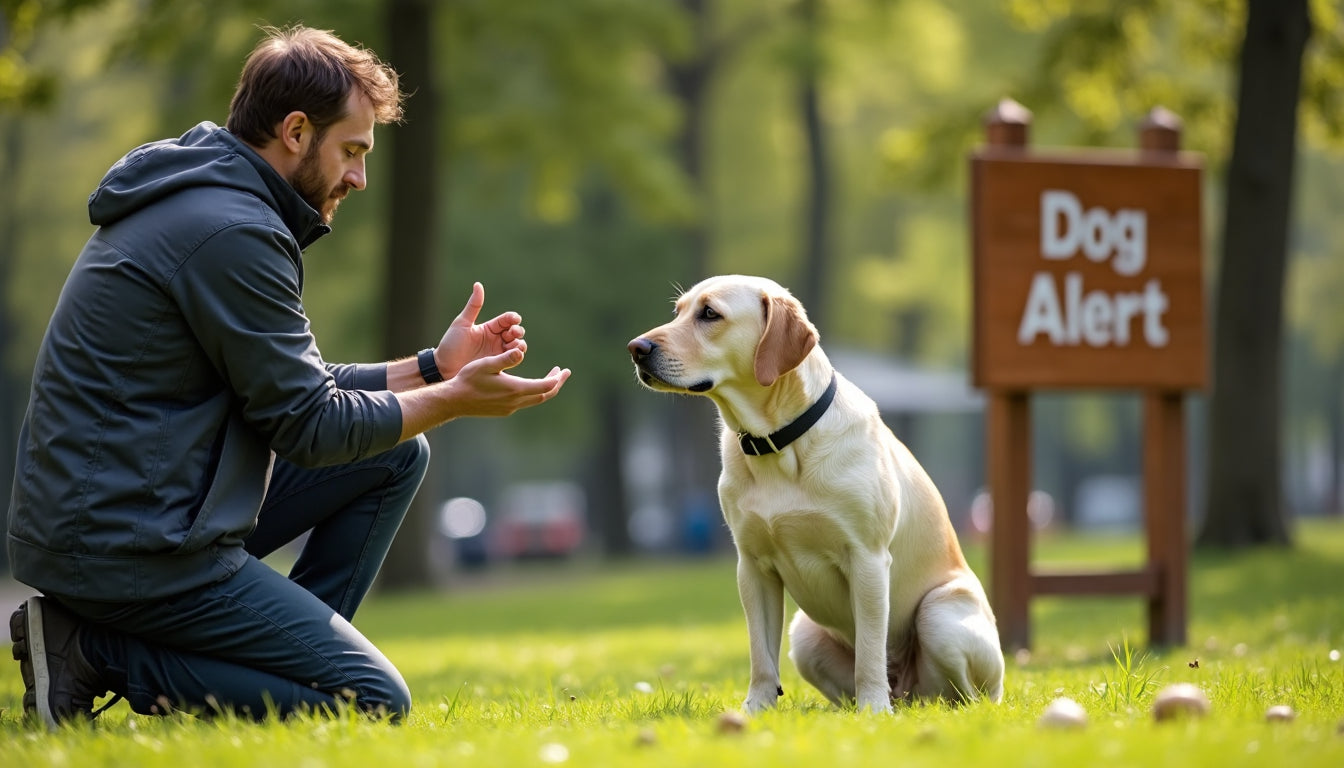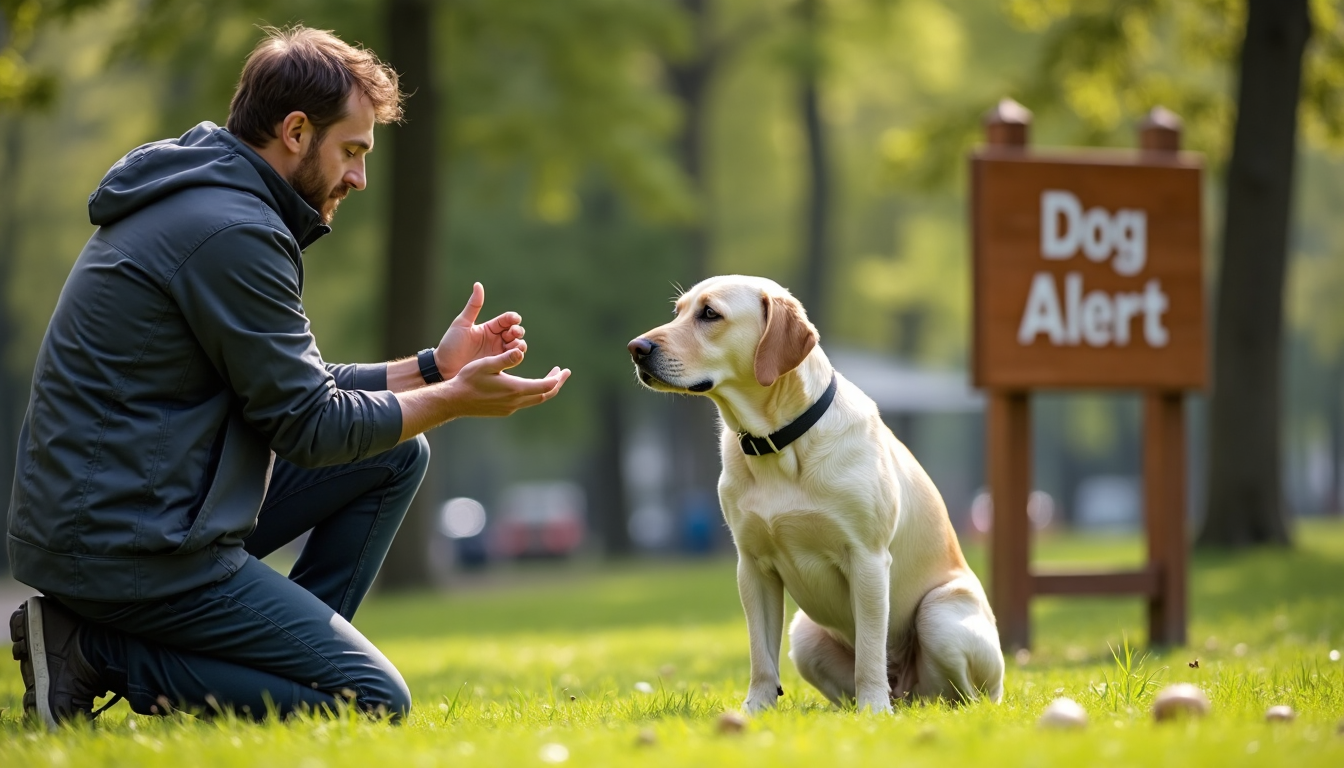
Dog alert training is becoming more critical as pets take on lifesaving roles for their handlers. Here is a wild fact. AI and augmented reality can now improve rescue dog response speeds by up to 22 percent in real emergencies. Most people think old school treats and patience are enough, but the real breakthroughs in 2025 are coming from high tech, science-backed methods you probably have never considered.
Table of Contents
- Understanding Different Dog Alert Types
- Essential Dog Alert Training Methods
- Common Challenges And Practical Solutions
- Advanced Tips For Service And Rescue Dogs
Quick Summary
| Takeaway | Explanation |
|---|---|
| Understanding Alert Types is Crucial | Knowing the different types of dog alerts (medical, environmental, specialized) helps handlers train dogs effectively for specific needs. |
| Implement Marker Training Techniques | Using clear signals like clickers provides immediate feedback, improving dogs’ understanding of desired behaviors. |
| Focus on Reward-Based Learning | Positive reinforcement leads to higher motivation and better performance, creating an engaging training environment. |
| Address Challenges Through Objective Training | Implementing standardized assessment methods and blind testing can help mitigate handler biases and improve alert accuracy. |
| Explore Technological Integration for Advanced Training | Leveraging AI and augmented reality can enhance performance in service and rescue dogs, improving their effectiveness in complex scenarios. |
Understanding Different Dog Alert Types
Dog alert training methods involve teaching canines to communicate specific information through distinct behaviors. These alerts serve critical functions for handlers with diverse needs, ranging from medical assistance to safety monitoring. Understanding the nuanced types of dog alerts becomes essential for effective communication and support.
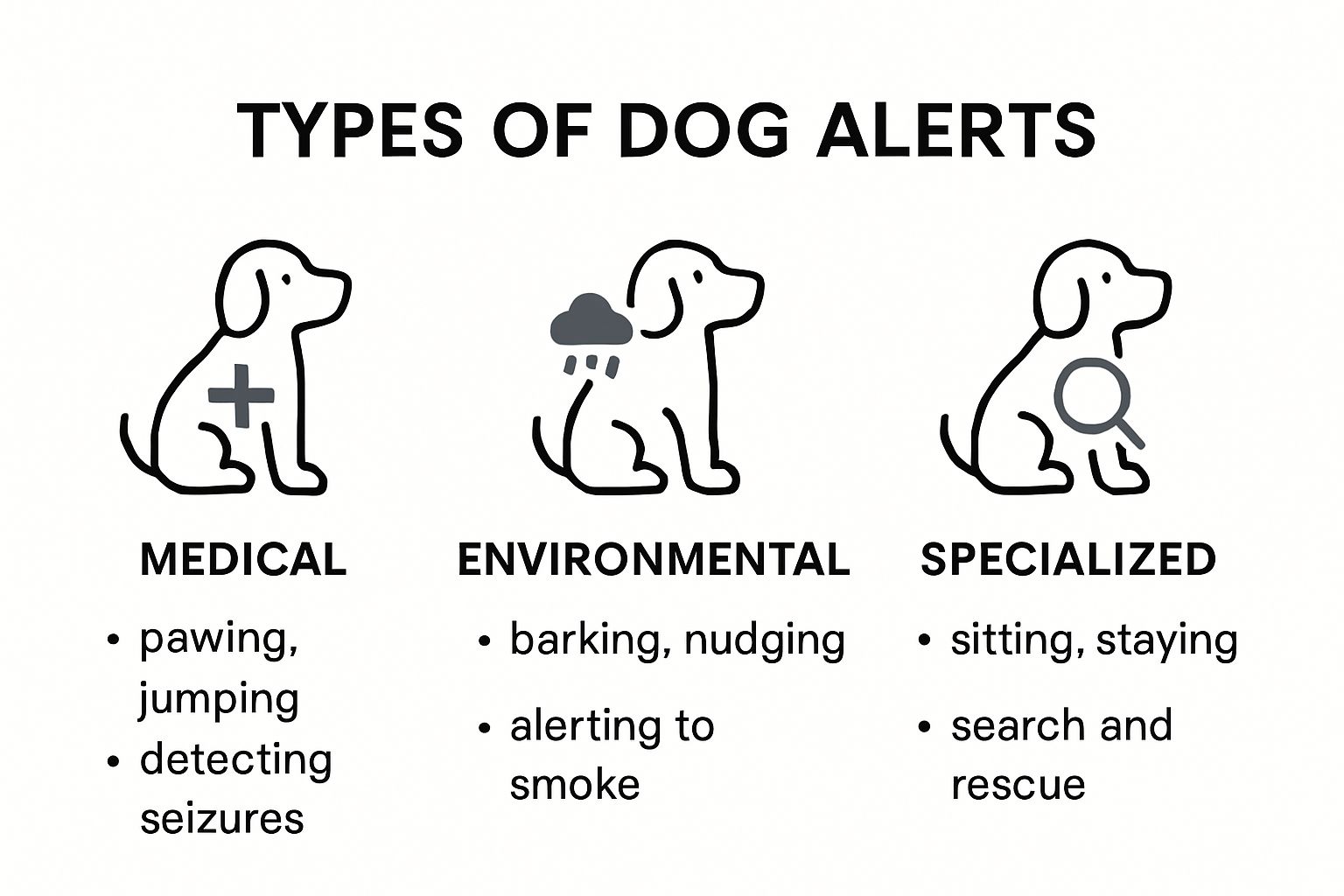
Medical Alert Behaviors
Assistance dogs are trained to perform specialized alert behaviors that can potentially save lives. Research from assistance dog experts reveals multiple alert mechanisms dogs can develop. For individuals with medical conditions like epilepsy or diabetes, dogs learn precise signaling techniques such as:
- Nudging: Physically alerting the handler to an impending medical event
- Circling: Positioning themselves strategically to protect or draw attention
- Specific Vocalization: Using controlled barking patterns to communicate urgent situations
Environmental and Safety Alerts
Seizure response dogs demonstrate remarkable training in detecting and responding to potential health risks. These canines are not just companions but highly trained medical support partners. They can activate emergency systems, find help, or provide physical stabilization during a medical episode.
Detection training involves sophisticated marker techniques that enhance a dog’s ability to recognize specific odors and environmental changes. Scientific studies confirm that targeted training improves dogs’ detection accuracy and alert precision.
Specialized Alert Communication
Beyond traditional medical alerts, dogs can be trained for diverse communication needs. Service dogs learn to communicate through intentional behaviors like:
- Pawing: Drawing immediate attention
- Positioning: Strategically placing themselves to block or guide
- Sound Signaling: Using specific bark patterns
These alert methods require extensive, patient training that focuses on clear communication between the dog and handler. Learn more about advanced dog alert options to understand the comprehensive training techniques used by professional canine communication specialists.
The complexity of dog alert training demonstrates that these remarkable animals are more than pets they are intelligent communication partners capable of providing critical support across various human needs.
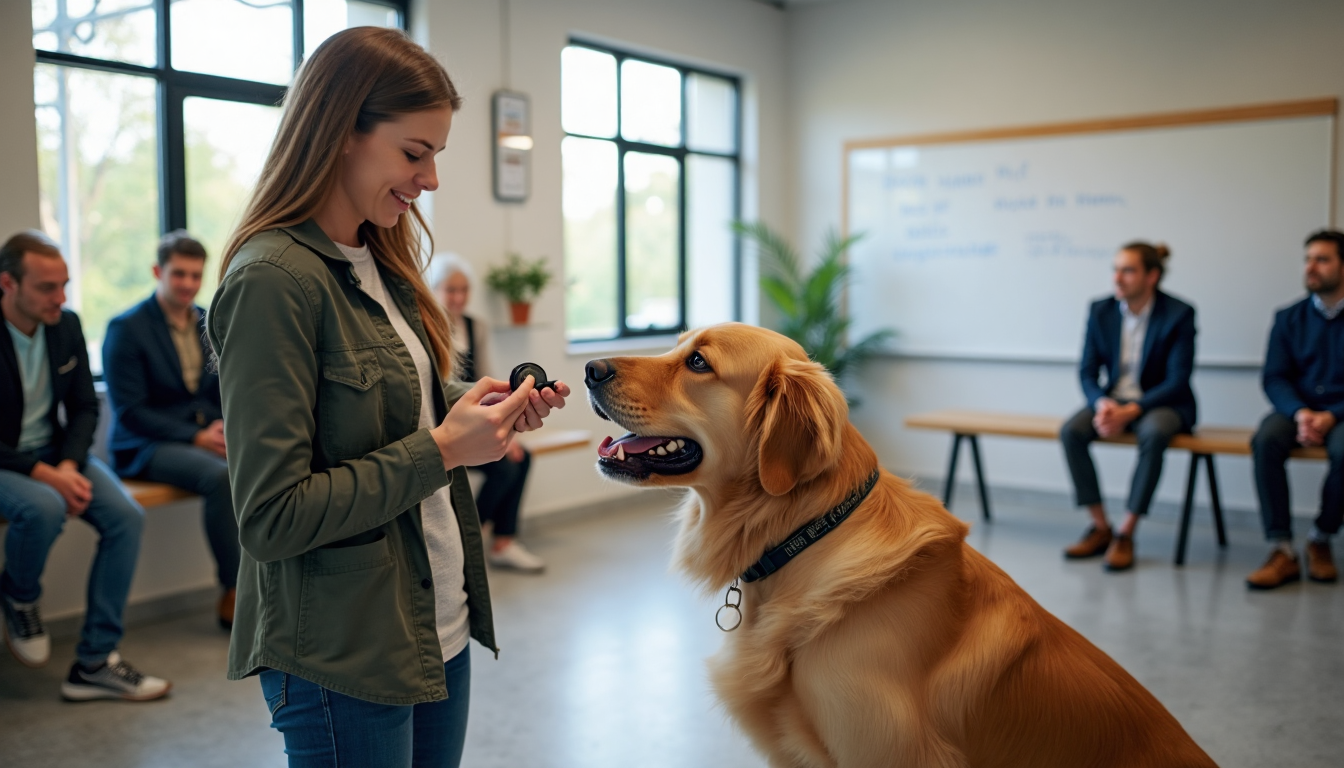
To better illustrate the types of alert behaviors dogs can be trained for, here is a summary table comparing medical, environmental, and specialized alert signals and their corresponding uses:
| Alert Type | Common Signals | Typical Uses |
|---|---|---|
| Medical | Nudging, Circling, Specific Vocalization | Warning of seizures, low blood sugar, or other medical events |
| Environmental | Emergency Activation, Seeking Help, Physical Stabilization | Responding to hazards, finding assistance, ensuring safety |
| Specialized | Pawing, Positioning, Sound Signaling | Alerting to doorbells, guiding in crowds, blocking pathways |
Essential Dog Alert Training Methods
Developing effective dog alert training methods requires a strategic approach that combines scientific understanding with patient, consistent techniques. Professional trainers recognize that successful alert training goes beyond simple commands, focusing instead on building robust communication pathways between dogs and their handlers.
Marker Training Techniques
Research from animal behavior experts demonstrates that marker training represents a sophisticated approach to teaching precise alert behaviors. This method uses clear signals like clicker sounds or verbal markers to communicate exact moments of desired performance. The technique allows dogs to understand precisely which behavior earns a reward, creating a more precise learning environment.
Key marker training principles include:
- Immediate Feedback: Marking the exact moment of correct behavior
- Consistent Reinforcement: Using predictable reward systems
- Clear Communication: Establishing unambiguous signals
Reward Based Learning
Scientific studies reveal that reward based training significantly improves learning outcomes and behavioral responses. Dogs trained through positive reinforcement exhibit higher motivation, reduced stress, and more consistent alert performances. This approach transforms training from a potentially punitive experience into an engaging interaction that strengthens handler dog bonds.
Successful reward strategies involve:
- High Value Treats: Using specially selected rewards
- Variable Reinforcement: Randomizing reward patterns
- Progressive Challenge: Gradually increasing task complexity
Handler Influence and Objective Training
Behavioral research highlights a critical aspect of alert training: handler expectations can significantly influence dog performance. Professional trainers must maintain objectivity, ensuring that training focuses on clear, measurable behaviors rather than unconscious handler biases.
Explore our comprehensive guide to advanced dog alert options to understand how sophisticated training techniques can transform communication between dogs and their handlers.
Ultimately, successful dog alert training demands patience, scientific understanding, and a commitment to building trust. By employing evidence based methods that respect the dog’s cognitive abilities, handlers can develop remarkable communication partnerships that provide critical support across various life scenarios.
To clarify the different training approaches discussed, here’s a table comparing marker training, reward-based learning, and objective assessment techniques:
| Training Method | Key Features | Main Benefits |
|---|---|---|
| Marker Training | Clickers/verbal signals, immediate feedback | Precise behavior shaping, clarity |
| Reward-Based Learning | High value treats, variable reinforcement | Increased motivation, reduced stress |
| Objective Assessment | Standardized protocols, blind testing | Reduces bias, ensures reliability |
Common Challenges and Practical Solutions
Dog alert training presents complex challenges that require sophisticated approaches and strategic problem solving. Handlers and trainers must navigate multiple obstacles to develop reliable communication systems that effectively support diverse human needs.
Detection and Generalization Challenges
Research from canine behavior experts reveals significant complexities in training dogs to generalize alert responses across varied environmental conditions. Detection dogs must learn to maintain precise alert behaviors despite variations in odor presentation, environmental factors, and potential interference.
Key generalization challenges include:
- Environmental Variability: Maintaining consistent performance across different settings
- Odor Discrimination: Recognizing specific target scents amid complex backgrounds
- Sensory Interference: Managing distractions that might compromise alert accuracy
Handler Influence and Bias Mitigation
Scientific studies demonstrate that handler expectations and unintentional cues can dramatically impact a dog’s alert performance. Unconscious body language or anticipatory behaviors can trigger false alerts or suppress genuine detection signals.
Practical strategies to minimize handler bias involve:
- Objective Training Protocols: Implementing standardized assessment methods
- Blind Testing: Creating scenarios where handlers cannot predict outcomes
- Regular Performance Evaluations: Conducting systematic skill assessments
Training Maintenance and Skill Retention
Marker training research highlights the importance of continuous reinforcement to maintain alert skills. Dogs require consistent practice and progressive challenges to prevent skill degradation and maintain high performance levels.
Effective maintenance techniques include:
- Periodic Skill Refreshers: Regular short training sessions
- Progressive Complexity: Gradually increasing task difficulty
- Varied Practice Environments: Training across multiple settings
Check out our comprehensive guide on overcoming service dog training obstacles to understand advanced strategies for developing reliable alert communication.
Successful dog alert training demands patience, scientific understanding, and a commitment to ongoing learning. By recognizing potential challenges and implementing targeted solutions, handlers can develop robust communication partnerships that provide critical support across various life scenarios.
Advanced Tips for Service and Rescue Dogs
Service and rescue dogs represent the pinnacle of canine training, requiring exceptional skills, precision, and adaptability. These extraordinary animals must navigate complex environments and perform critical tasks that can save lives, making their training incredibly sophisticated and nuanced.
Technological Integration in Training
Cutting edge research reveals remarkable advancements in canine training technologies. The KHAIT system demonstrates how artificial intelligence and augmented reality can dramatically enhance search and rescue dog performance. By equipping dogs with AI powered cameras and AR headsets, trainers can improve survivor localization and decrease allocation time by up to 22 percent in challenging environments.
Key technological training approaches include:
- AI Enhanced Tracking: Using machine learning algorithms to refine detection skills
- AR Navigation Training: Simulating complex rescue scenarios
- Precision Sensor Integration: Developing dogs’ sensory perception capabilities
Errorless Learning Techniques
Scientific studies highlight the significance of errorless learning techniques in developing advanced canine discrimination skills. This innovative approach minimizes incorrect responses during training, allowing dogs to build robust cognitive frameworks for complex tasks.
Errorless learning strategies involve:
- Controlled Stimulus Exposure: Gradually introducing varied environmental scenarios
- Positive Reinforcement Protocols: Focusing on successful behavior patterns
- Incremental Task Complexity: Systematically increasing training difficulty
Generalization and Adaptive Training
Behavioral research demonstrates that exposing service and rescue dogs to diverse positive and negative stimuli significantly enhances their ability to generalize complex discriminations. This approach enables dogs to perform more effectively across unpredictable environments and scenarios.
Training methodologies for adaptive performance include:
- Multi Environment Training: Practicing skills in varied settings
- Stress Resistance Development: Building emotional resilience
- Sensory Discrimination Exercises: Refining detection capabilities
Discover comprehensive insights into service dog skill development to understand the intricate process of transforming intelligent dogs into life saving partners.
The future of service and rescue dog training lies in a holistic approach that combines advanced technological tools, scientific understanding, and profound respect for the dogs’ incredible cognitive abilities. By continually pushing the boundaries of training methodologies, we unlock extraordinary potential in these remarkable animals.
Frequently Asked Questions
What are the different types of dog alert behaviors?
Dog alert behaviors can be categorized into medical alerts, environmental and safety alerts, and specialized communication. Medical alerts involve signaling specific health events, environmental alerts respond to potential risks, and specialized communication encompasses various intentional behaviors like pawing or sound signaling.
How can technology improve dog alert training?
Technology enhances dog alert training through tools like artificial intelligence and augmented reality. These innovations improve training efficiency and effectiveness, allowing dogs to respond more quickly and accurately in complex scenarios, ultimately saving lives.
What methods are most effective for dog alert training?
Effective dog alert training methods include marker training techniques, reward-based learning, and objective assessment tactics. These approaches focus on clear communication, positive reinforcement, and eliminating handler biases to ensure reliable alert behaviors.
What challenges do trainers face in dog alert training?
Trainers often encounter challenges such as detection and generalization issues, handler influence, and maintaining skill retention. Implementing structured protocols, blind testing, and ongoing training are essential to overcoming these obstacles.
Transform Dog Alert Training Success Into Real-World Safety
Are you worried that even the most advanced dog alert training methods can fall short when real emergencies happen? The article highlights how handler bias, inconsistent alerts, and the limits of traditional cues often stand between service dog teams and true communication. Handlers need more than just persistence—they need tools that reinforce everything covered in top-tier training, like marker feedback and reliable signaling.
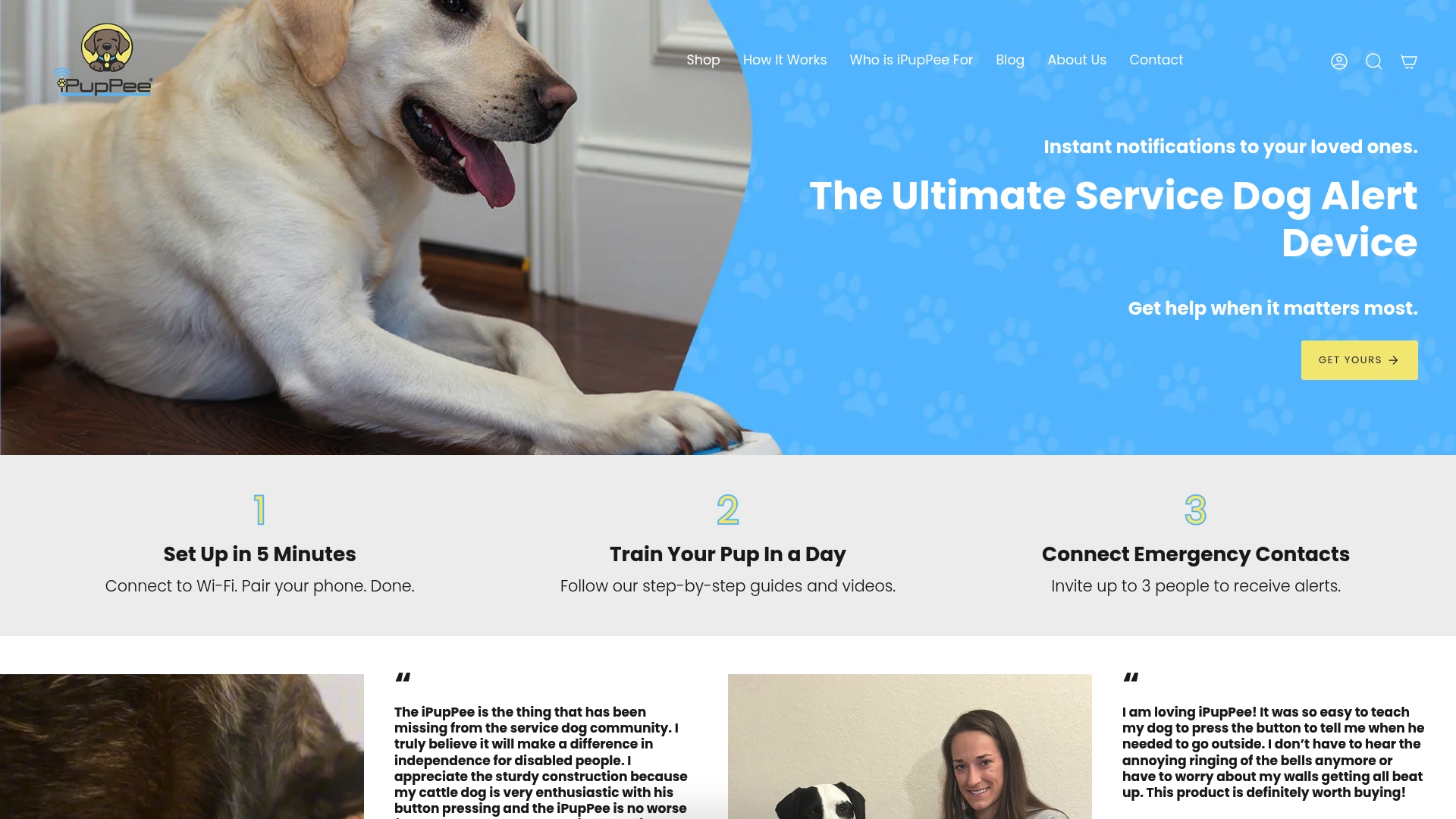
Choose a smarter way to strengthen your dog’s alert effectiveness. The iPupPee communication device bridges the gap by giving your dog a voice they cannot misinterpret. It supports key training concepts such as immediate feedback and clear, intentional signals, aligning perfectly with the evidence-based methods described in our guide. This means fewer false alerts and more safety every day for service dog handlers, seniors, or anyone seeking independence through their dog.
Act now to empower your training and daily peace of mind. Visit iPupPee.com to discover how our unique device can help your dog deliver life-saving communication right when you need it most. Explore our proven solutions and step confidently into a safer future for you and your dog.
Recommended
-
https://ipuppee.com/blogs/news/training-techniques-for-dogs-guide-owners-handlers-2025)
-
https://ipuppee.com/blogs/news/dog-behavioral-training-guide-2025)
-
https://ipuppee.com/blogs/news/how-to-teach-dogs-basic-commands)
-
https://ipuppee.com/blogs/news/expert-dog-obedience-training)
-
https://ipuppee.com/blogs/news/dog-alert-signals-recognize-respond-2025)
-
https://ipuppee.com/blogs/news/how-dogs-learn-simple-guide-2025)

